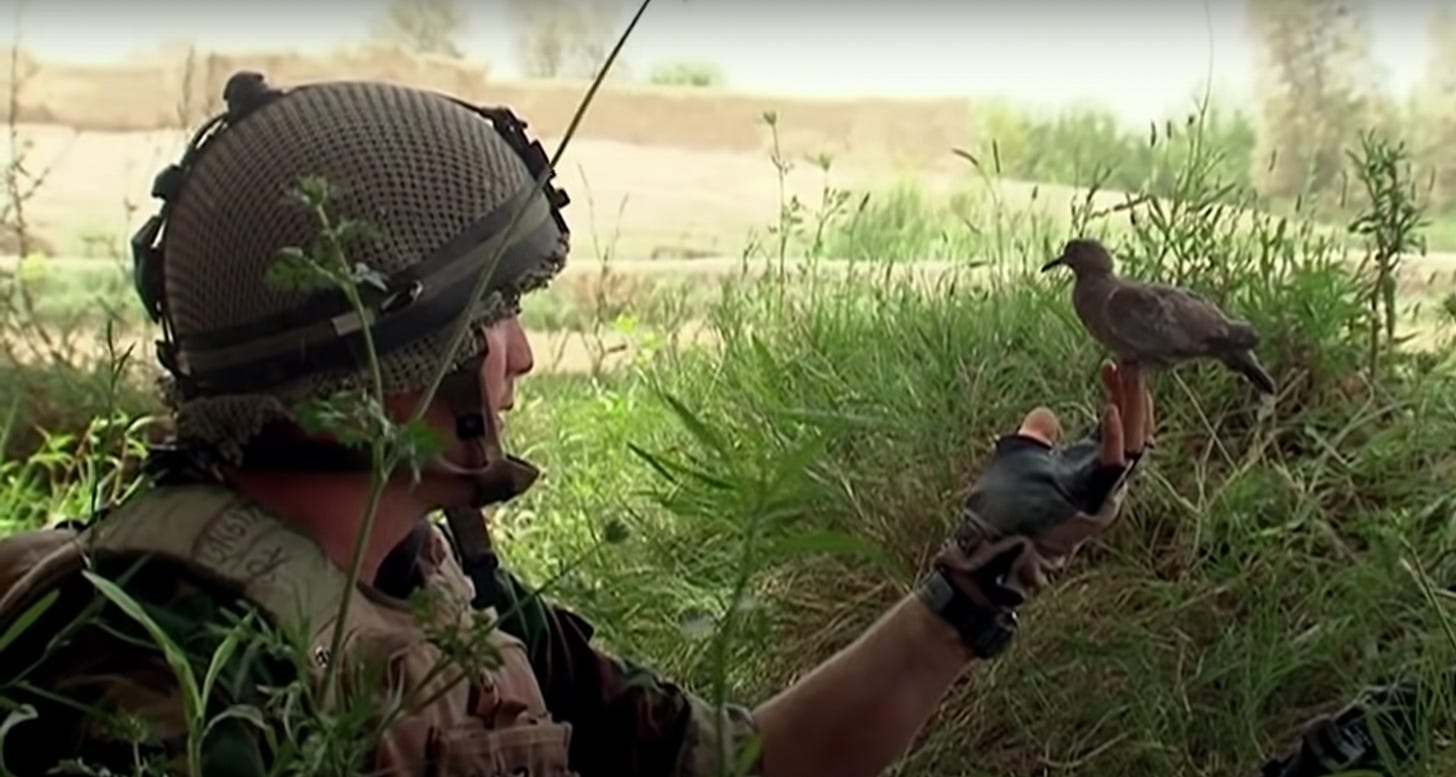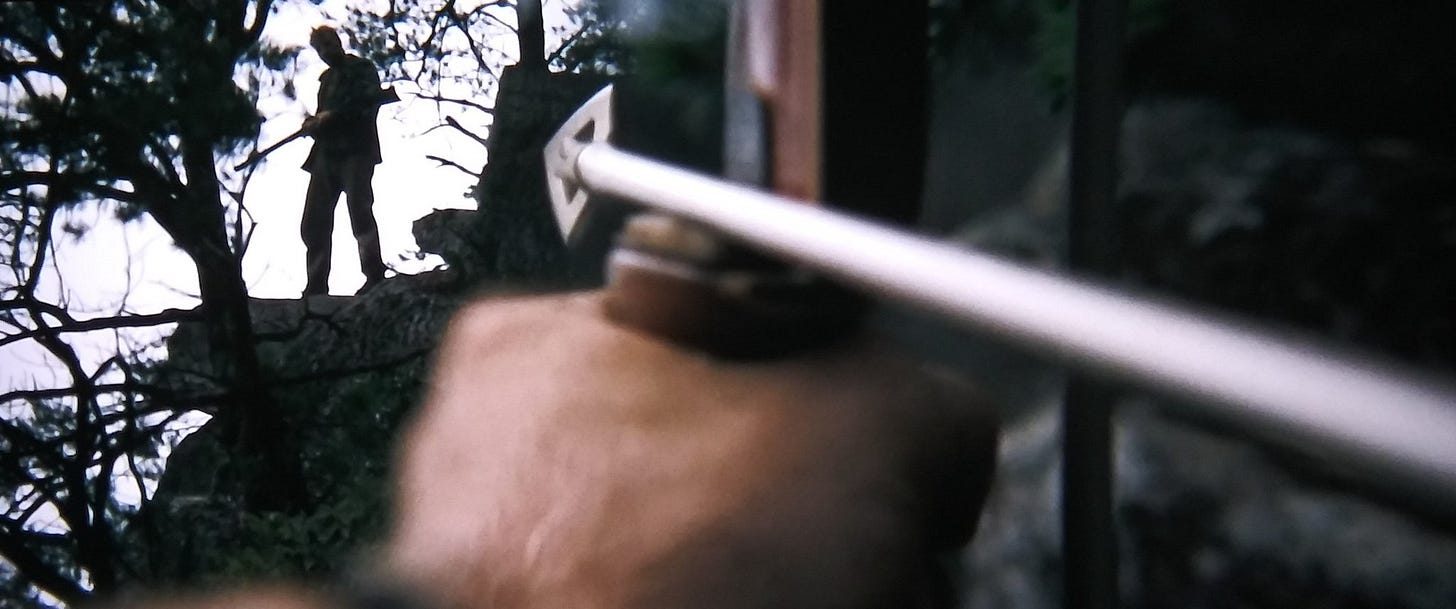Deep Cuts
Four unflinching films about violence you maybe haven’t seen and definitely can’t unsee

If 2025 were a movie, it would begin at sunrise on New Year’s Day, in the porte cochère of Trump International Hotel Las Vegas. A gleaming Tesla Cybertruck glides up to the entrance. Seconds later, it explodes.
The movie could end there. Or not, whatever.
When I watched the CCTV footage of U.S. Army Special Forces soldier Matthew Alan Livelsberger, a married 37-year-old and father of a newborn, obliterate himself in a fireball, I had a wildly inappropriate thought: damn, that’s a nice shot. Early morning light. Long desert shadows. The explosion, a Bruckheimer-esque bloom of fire and debris, arcing in balletic symmetry. I felt like a shitbag for admiring this. Then I realized—the shot was the point. Livelsberger must have been picturing it.
The shot was everything.
So begins “Explicit Content,” my essay out this week in the new issue of
- a sprawling, jacked-up investigation into how we stopped worrying about violence in cinema, and started seeking cinema in real-world violence.It is the longest, most elaborate film essay I’ve ever written, and as you can already tell, I’m obnoxiously proud of it. You can give it a read on The Point website now.
While you’re there, enjoy some other essays in this issue from brilliant minds like
and (whose Substacks I adore), Claudia Verhoeven, Mary Gaitskill, Sophie Pinkham, and more.For the uninitiated, The Point is a Chicago-based magazine that explores ideas of philosophical significance through essays on literature, culture, critical theory, politics, and the arts. They’re also on Substack, and you should absolutely subscribe.
Here’s another snippet from my essay:
Tumblr, a microblogging platform known for fan art, soft grunge and tweeny self-obsession, became an unlikely breeding ground for murder fandoms around 2012, just as the true-crime craze hit its cultural peak. On “True Crime Tumblr,” populated mostly by teen girls, mass-murderer fan fiction, video montages and chibi-style anime abounded. Some reimagined Harris and Klebold as bullied outcasts (they weren’t), while others “shipped” serial killers in imagined gay pairings, warping real-life carnage of the past into the bubbly vaporwave fantasies of now.
… Ok, one last nibble from a later section:
In “Empty Moments,” film scholar Leo Charney argues that drift - the inability to hold onto a stable present - is the defining feature of modernity.
Violent spectacle jolts us into momentary contact with something that feels real, however horrifying. Social media, like Edison’s cinema of attractions, doles out violence as a stimulant. By discarding context and moral frameworks, the violence is aestheticized and reduced to slop—slickly produced yet strangely hollow, gesturing at importance without actually achieving it.
This week’s feature, Deep Cuts, starts below the fold. But first, the news.
News Reel
Charlie Kaufman, the Oscar-winning screenwriter behind Eternal Sunshine of the Spotless Mind and Being John Malkovich, is releasing his next film directly to libraries. How to Shoot a Ghost will debut at the Venice Film Festival in September before streaming on Kanopy, which is free to users with a library card. “Given the crisis of education in this country, it remains as important as ever for citizens to continue to have barrier-free access to the wealth of free resources that libraries have always offered,” said Kaufman in a statement.
- of asked a small group of media execs and legacy journalists to anonymously share their thoughts on the state of the industry. The takes arrived scorching hot, and are worth a read. Here’s one I happen to agree with: “We need gatekeepers again - new, more diverse ones. Taste isn’t a democracy, nor should it be populist. It comes from experience and exposure. Just because you eat doesn’t make you a restaurant critic.”
Disturbing new research from the Financial Times shows that the internet age has significantly reshaped our personalities, with positive traits like empathy, conscientiousness, and agreeableness plummeting, particularly among younger adults - while neuroticism is on the rise. In an unrelated neurocognitive study, watching film and cultivating the cinematic imagination was shown to have transformative power, shifting our focus “from body to world.” Which screen will it be for you, friend? The small one that dulls your personality, or the big one that expands it?
Underexposed is a weekly ad-free film publication, funded by an unruly band of readers like you. If you believe in the power of cinema and the magic of discovery, consider upgrading to a premium subscription for exclusive essays and videos.
Deep Cuts 🔪
As a companion to “Explicit Content,” here are four movies that have challenged and upended my views on violence in fascinating ways.
4. Bitter Lake (2015, Adam Curtis)
Documentarian Adam Curtis has been haunting the archives of the BBC for over three decades now, weaving forgotten footage into poignant, probing and surprisingly poetic essays about the making of our modern world, and its consequences. His most famous docs, like Hypernormalization or the Century of the Self, touch on subjects as varied as the tormented love life of Ayn Rand, the invention of public relations, and the interwoven histories of neoconservatism and militant Islamism.
In Bitter Lake, his 2015 film about Afghanistan, Curtis suggests that Western politicians have spun a tragically simplistic fable about militant Islam - a tale of good and evil - mostly in response to the growing disorder in their own societies. The title refers to a lake near the Suez Canal, where a 1945 meeting between President Franklin D. Roosevelt and King Abdulaziz of Saudi Arabia set events in motion that led to the decades-long quagmire in Afghanistan. “It is a quagmire the West chose—a trap it built, bit by bit, and then threw itself upon,” wrote critic Robert Gifford in his review of the film, which he called “a brutal, enraging, dispiriting film, but a necessary one.” Bitter Lake is a kaleidoscopic portrait of the business of violence - who it serves, and who it sacrifices to fruitless bloodshed. You can watch it on YouTube.
3. The Butcher (Le Boucher, 1970, Claude Chabrol)
Le Boucher may be the least violent movie about violence - at least, on the surface. In a quiet provincial French town, Popaul, a butcher, befriends Hélène, the local schoolteacher. Their relationship is warm but restrained - she’s wary of romance, he’s a war veteran carrying psychological scars. When a series of brutal murders of young women rocks the community, Hélène notices unsettling coincidences that suggest Popaul might be the killer. But instead of going to the police, she finds herself drawn to the brutality.
Claude Chabrol is an “underexposed” director if there ever was one - particularly outside of France. As a young critic at Cahiers du Cinéma, he stole off and started the French New Wave with Le Beau Serge (1958), then went on to direct fifty more films and become anointed as the “French Hitchcock.” Le Boucher is one of his masterpieces.
For my money, Le Boucher has one of the all-time best endings - one that provokes you to consider who the real butcher in this story might be. You can watch it here.
That’s all for the free edition. Paid subscribers, leap ahead. If you want to see the final two, and support my efforts to keep movie culture alive and screaming, consider upgrading to a paid subscription.
Keep reading with a 7-day free trial
Subscribe to Underexposed to keep reading this post and get 7 days of free access to the full post archives.




